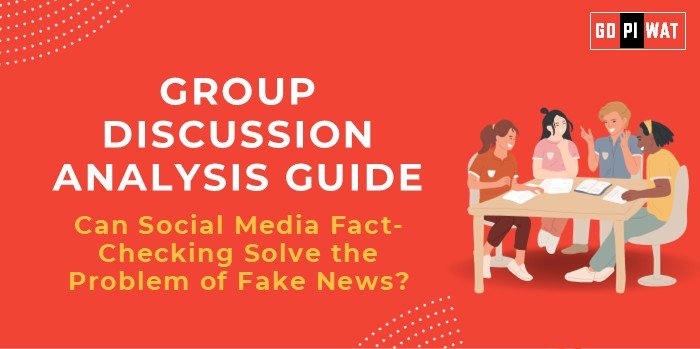📋 Group Discussion (GD) Analysis Guide
🗨️ Can Social Media Fact-Checking Solve the Problem of Fake News?
🌟 Introduction
📜 Opening Context
Fake news has become a global concern, impacting elections, public safety, and social trust. With 4.9 billion active social media users worldwide, these platforms are both a source of information and misinformation. Fact-checking initiatives have emerged as a solution, but their effectiveness in combating fake news remains debated.
📖 Topic Background
Social media companies, governments, and independent organizations are increasingly adopting fact-checking mechanisms. In India, for instance, platforms like WhatsApp and Twitter partner with independent fact-checkers to curb misinformation during elections. However, questions about bias, scalability, and the potential for censorship persist.
📊 Quick Facts and Key Statistics
- 🌍 Active Social Media Users: 4.9 billion globally (2024) – Illustrates the widespread influence of these platforms.
- 📈 Fake News Impact: 59% of people globally encounter misinformation weekly (Reuters Institute, 2023).
- 📚 Fact-Checking Organizations: Over 350 globally, working with platforms like Meta and Twitter.
- 🇮🇳 India’s WhatsApp Fact-Check Pilot: Handled over 5,000 queries during the 2024 general elections.
🤝 Stakeholders and Their Roles
- 💻 Social Media Platforms: Implement fact-checking tools and algorithms.
- 🏛️ Governments: Regulate misinformation and provide legislative frameworks.
- 🔍 Fact-Checking Organizations: Verify claims and provide evidence-based conclusions.
- 🧑🤝🧑 Citizens: Exercise media literacy and report fake news.
- 🤖 Tech Developers: Create AI tools for detecting misinformation.
✅ Achievements and Challenges
🎉 Achievements
- Increased Awareness: Fact-checking prompts educate users; Twitter labels reduce spread by 20%.
- Election Integrity: Platforms reduced misinformation by 45% during U.S. elections (Meta, 2020).
- AI Tools: Advances like Google Fact Check Explorer assist journalists in verifying news quickly.
⚠️ Challenges
- Scalability Issues: Global platforms face difficulty addressing local misinformation in multiple languages.
- Bias Allegations: Concerns over political and cultural bias in fact-checking initiatives.
- Censorship Risks: Efforts to curb misinformation sometimes infringe on freedom of speech.
🌍 Global Comparisons
- 🎯 Success: Estonia uses AI-driven tools for fact-checking during elections, with measurable reductions in fake news.
- ❌ Challenge: Brazil’s misinformation campaigns on WhatsApp demonstrate limits to human moderation.
📚 Case Study
During the COVID-19 pandemic, India saw a surge in fake news about vaccine safety. Fact-checking efforts on WhatsApp and Twitter helped dispel major myths but failed to reach rural areas effectively.
📌 Structured Arguments for Discussion
- ✅ Supporting Stance: “Fact-checking has successfully reduced misinformation during critical events like elections and public health crises.”
- ❌ Opposing Stance: “Fact-checking is limited by language barriers, scalability, and accusations of bias, making it an incomplete solution.”
- ⚖️ Balanced Perspective: “While fact-checking can curb misinformation, broader efforts like media literacy and algorithmic transparency are needed to solve fake news comprehensively.”
💡 Effective Discussion Approaches
- Opening Approaches:
- Start with a statistic: “Fake news affects 59% of global social media users weekly, showcasing the urgent need for solutions.”
- Use a case study: “During India’s elections, fact-checking on WhatsApp helped limit political misinformation.”
- Counter-Argument Handling:
- Bias Concerns: “Bias in fact-checking can be minimized with transparent methods and diverse representation in fact-checking teams.”
- Scalability: “AI tools like Google Fact Check Explorer can scale efforts to multiple languages.”
📈 Strategic Analysis of Strengths and Weaknesses
- 💪 Strengths: Educates users, protects democratic processes, reduces virality of fake news.
- 🛠️ Weaknesses: Limited reach in rural areas, potential for censorship.
- 🚀 Opportunities: AI integration, partnerships with governments, global standards.
- ⚡ Threats: Resistance from political groups, evolving tactics by misinformation spreaders.
🏫 Connecting with B-School Applications
📘 Real-World Applications
- Linking to project themes in technology management, ethics in business communication, or policy-making.
🎯 Sample Interview Questions
- “How would you evaluate the impact of social media fact-checking on elections?”
- “Can AI tools be trusted to handle sensitive fact-checking issues?”
🧠 Insights for B-School Students
- Focus on balancing free speech with regulation.
- Explore emerging tools in media ethics and AI.


